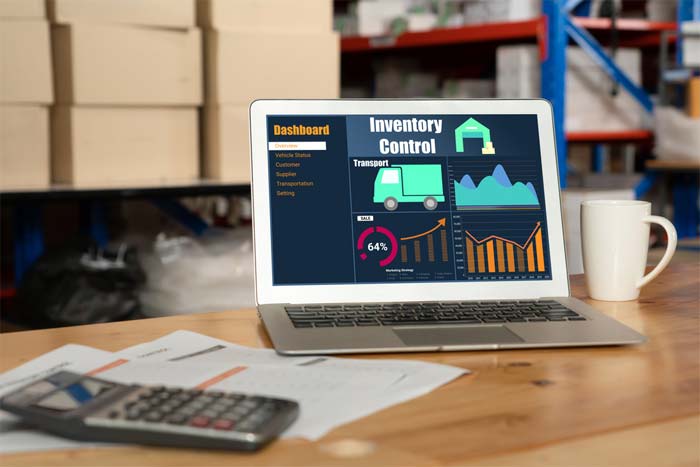Inventory management is a crucial component to supply chain management that ultimately helps you keep track of your physical goods.
What Is Inventory Management?

According to Investopedia, the inventory management definition is when a business orders and stores its inventory. The complexity of any company’s inventory management will depend on the intricacy of both their existing supply chains and manufacturing processes.
The inventory management system maintains track of each item, order shipment, and arrival. It will be responsible to keep track of inventory levels, ensuring that there is enough product to meet demand and that the products are being stored properly. It is also responsible for removing and disposing of expired, spoiled, or damaged goods.
Why Is Inventory Management Important?

Whether it be relatively simple or complex, the importance of inventory management is undeniable. Directly impacting every aspect of your business, your inventory management will determine a number of different things, including warehousing costs and fulfillment capabilities.
Inventory management will also influence your storage facilities, which can often prove essential in coping with seasonal and cyclical peaks. With inventory management properly organized, you’ll be able to easily track your product location and availability.
An inventory management system will simplify the ordering, storage, and use of inventory. It automates end-to-end production, demand forecasting, and business management.
In addition, Inventory management plays a role in customer service and satisfaction. A well-managed inventory can even contribute to the longevity of your company.
Inventory Management vs. Inventory Control

Inventory management and inventory control are very similar in terms of supply chain management.
As a distributor, it is essential to understand the difference between inventory management and inventory control to maximize your capacities.
Inventory control refers to the regulation of your inventory that already exists within your warehouse. The control in ‘inventory control’, refers to knowledge of the following things:
- What products you have in stock
- Quantity of any particular item currently available
- Location of every product within your warehouse
- Maintenance of quality of products within your warehouse
- Warehouse layout to maximize order fulfillment process
Although often confused, inventory management covers a broader scope of responsibilities within its threshold. Inventory management includes additional qualities revolving around product replenishment, including:
- Forecasting
- When to order more product
- How much more product to order
- Sourcing the most effective supply for your warehouse
Inventory management and inventory control work hand-in-hand together. To have a more effective inventory management system, you must first focus on your current inventory control.
As a distributor, you must always remember that because inventory is your largest asset, fixing your warehouse inefficiencies is critical for your profitability.
Types of Inventory

The inventory in your warehouse belongs to one of the various classifications throughout its journey along the supply chain. Distributors should account for each of their products and identify which stage it currently is in the chain.
There are four primary stages in the inventory management system: inventory, raw materials, unfinished products, in-transit inventory, and cycle inventory.
Raw Materials
Not all warehouses are created equal since some are responsible for carrying unfinished products. These unfinished products, or raw materials, are stored in distribution centers as an added element to their production line.
The raw material is an integral part of any inventory management process. Factory machinery and assembly lines are at a standstill until the warehouse distributors receive their raw material.
Distributors should always clearly identify the difference between which items are raw materials and which ones are ready for business use. Also, proper monitoring of raw materials within your warehouse is an essential step. Failing to inspect raw materials closely could directly impact your warehouse’s ability to remain open and functioning.
Raw materials don’t only refer to the manufacturing assets but also any business tools critical to your warehouse operation. An example of raw material inventory is shipping pallets. A shortage of shipping pallets could cause the business to crash. Therefore, it’s vital to keep accurate notes of all raw materials.
Unfinished Products
At the next step in the supply chain, your raw materials will move on to manufacturing, where they might need to return to the warehouse shelves before selling. Again, this is another critical point where warehouse workers might confuse unfinished products with those that are ready for business use.
Data collection devices are available to help with this particular inventory management process, allowing employees to update the status of every item they touch in the warehouse. Today, there are mobile devices that streamline this process even further. Different options include:
- Barcode scanners
- Smartphones
- Tablets
- Voice picking technology
Depending on what makes the most sense for your warehouse, each of these mobile data collection procedures will help you to minimize the risk of mistakes.
In-Transit Inventory
In-transit inventory is relatively self-explanatory but refers to the merchandise that your warehouse has not yet received. Although it seems basic enough, distributors often overlook in-transit inventory because the physical product is not within the warehouse.
Due to the nature of inventory management, it is impossible for your warehouse to have every item at all times. To keep up with demand, you will need to purchase inventory from manufacturers and suppliers. This is sent to your warehouse and stored in a space reserved for items that have not yet arrived: in-transit inventory.
Your data collection system will help you keep account of your in-transit inventory as long as you extend it properly. The mobile tools available to your warehouse workers can also be made available to distribution drivers.
Cycle Inventory
A particular classification for the inventory that moves quickly through your supply chain is known as cycle inventory. Cycle inventory accounts for a small percentage of shop inventory, yet has a greater impact on inventory management as a whole as it typically makes up the greatest percentage of inventory turnover.
It includes any products that arrive from the manufacturing process and almost immediately go out to customers. Because cycle inventory can be tricky to keep track of, your warehouse workers will need the most efficient tools available to them.
Cycle inventory can be ideal for a distributor for a couple of different reasons, the first being that it tends to indicate a higher demand for your products. Also, quicker movement through the supply chain results in minimized overhead.
Although it is best to have stock that turns over quickly, it can be very challenging to manage. Mobile data collection devices are crucial for anyone managing cycle inventory.
Factors Affecting Inventory Management

When you are looking to clean up your inventory management, there are several different factors, both internal and external, you will need to keep in consideration.
Financial
Financial factors can vary amongst distributors but can heavily influence the level of your inventory management. Some economic factors include:
- Borrowing money
- Fluctuating interest rates
- Tax costs
- Warehouse operational costs
- Transportation costs
- Fuel costs
Fuel costs are one of the more simple financial factors to consider. With the fluctuating rates of fuel cost, you might opt to look for alternative options to trucking your products across the country. Maybe, purchasing an additional warehouse in another location might be more cost-effective in the long run.
Suppliers
Maintaining a quality relationship with suppliers is crucial as a distributor. Suppliers are the lifeblood of any distribution operation. Your business relies entirely on your suppliers’ reliability, and disruptions with suppliers can result in product shortages or significant delays in manufacturing.
Lead Time
Lead time refers to the amount of time it takes for a product to arrive once ordered. It is important to consider the lead time when developing your product roadmap.
An option some distributors look for is to outsource manufacturing to other countries to minimize labor costs. Sometimes, though, these cost savings result in longer lead times.
Product Type
As a distributor, you must always keep in mind the types of products in your warehouse. Understanding perishables and shelf lives are very crucial to make sure expired items are not for business purposes.
Such items should either be returned to the supplier or sent to a donation center. Other types of inventories such as tools and equipment, apparel and footwear, and electronics have a limited lifespan.
If you have seasonal products, you should record the dates of arrival and departure so that you’ll know which items to keep on the shelves.
Management
Management of the warehouse’s inventory lies solely on you and any other co-owners. This management includes the direction of any other warehouse managers beneath you.
You will need to come up with a very straightforward system that can be easily understood by anyone involved. This system should ideally take the form of an inventory management software with real-time analysis.
It should keep information on all purchases, who’s responsible for managing inventory (if it’s not you), and when inventory is due to be counted.
Keeping track of purchases will help make sure that there is enough revenue coming in, and this will assist in your ability of inventory management.
External Factors
In addition to internal factors affecting inventory management, there are always external components to consider. While external factors are harder to predict, it is still equally important to be aware of their existence. Some examples of external factors include:
- Economic downturn
- Real estate market shift
- Local competition
Periodic Inventory vs. Perpetual Inventory

Periodic and perpetual inventory systems refer to accounting methods used in tracking the number of available products. The differences between perpetual and periodic inventory management couldn’t be more contrasting.
Periodic Inventory
The periodic inventory management system uses a physical count and the cost of goods sold (COGS) to measure inventory levels. These values get updated every period, whether it be monthly, quarterly, annually, etc.
Through the periodic inventory accounting system, you can find your COGS by calculating:
- Beginning balance of inventory + cost of inventory purchases – cost of ending inventory = COGS
Rather than wasting time physically counting all of your inventory in your warehouse, you might want to only perform these physical counts on a given period.
The one downside to periodic inventory is that the figures are not always going to be the most accurate.
Perpetual Inventory
Perpetual inventory is a type of inventory management system where data from regular transactions is used to update inventory records. The main purpose behind the perpetual inventory management system is to avoid stock-outs and overstocking by keeping track of both incoming and outgoing goods.
The perpetual inventory system calculates inventory levels by adding the cost of goods purchased to the beginning inventory, deducting items sold from those figures, and updating those numbers as each sale is made.
In a perpetual inventory management system, you continuously count all inventory balances. So much so that anytime a product is received, the inventory is automatically updated. Because inventory tracking is so automated, perpetual inventory has a more accurate picture of figures than periodic inventory.
Perpetual inventory uses digital technology to track all inventory accounts in real-time.
Scope of Inventory Management
Whether you choose to run your inventory management using a periodic or perpetual accounting system, you will base the scope on your warehouse’s strategic business targets. The scope of inventory management refers to everything, including the aspects in which you count or conduct your inventory and how you use this information.
For example, dishwasher manufacturers may use inventory information to help control their raw materials costs. On the other hand, a breakfast cereal manufacturer may use this same information to focus on turning their stock into cycle inventory to preserve freshness.
In large-scale supply chains, it’s crucial to have a more significant staff who is dedicated to your inventory management system of choice. In contrast, smaller operations may not demand a large team and top-of-the-line inventory management products like mobile devices.
Inventory Management Process

Although the different methods for which you choose to run your inventory management may vary in terms of tracking, either because of the technique, size, or industry, your inventory management process will likely follow the same procurement process:
Receive Goods
The first step in inventory management occurs when the goods get delivered to your warehouse. This delivery can mean any goods, including:
- Raw materials
- Finished goods
- Indirect materials
Review Goods
Once you receive the goods, you will want to make sure to review everything. Following the review, you will want to begin sorting and storing your goods in your specified warehouse areas. In this step of the inventory management process, some warehouses assign a stock-keeping unit (SKU) code via a barcode to help with inventory tracking future-forward.
Monitor Inventory
While your inventory is in your warehouse, you should always monitor it closely. Even if you use a perpetual inventory system, you should still conduct periodic inventory tracking routinely to ensure you have the most up-to-date information possible.
Customer Places Order
The next step in the inventory management process comes when a customer places an order. This customer can refer to an internal or external customer.
Order Approval
The customer’s order must get approval once you can verify it against the original sale.
Pull From Stock
Next, warehouse workers will pull the goods from their designated areas and send them to one of the following locations:
- Manufacturing
- Retailer
- Business or department (internal requests)
Update Records
Once the item leaves the shelves, you should immediately update your inventory records.
Restock Goods
Using your inventory management system, you will manage your inventory levels to determine when restock is necessary.
Tools of Inventory Management

In addition to the inventory management methods you decide to implement in your warehouse, some tools can help you run it even more effectively. Let’s look at some inventory management techniques that you might use in your warehouse.
Barcodes
The inventory management system uses barcodes in order to keep track of all the products that are being delivered or manufactured. Whenever barcodes are scanned and matched with a list, an accurate count and location will be available. While there can be inaccuracies in this inventory management technique due to human error, it reduces the risk of loss of the product on inventory.
When you collect data about your inventor manual, it can be incredibly time-consuming, costly, and be responsible for a series of errors. Through more automated data collection systems, you can lift your reporting burden for everyone involved. More often than not, automated data collection systems rely on the use of barcodes.
Cycle Counting
Cycle counting can take periodic physical inventory counts and alleviate some of the issues with inaccuracy. This proper inventory management method involves breaking down your inventory into smaller lists that are more specific to the products that must be counted.
Your products can be divided by product category, vendor, or warehouse location. This is possible with an inventory management system. With cycle counting, you count more important products more frequently than lower-valued products.
ABC Analysis
To set up cycle counting, you will typically have to do an ABC analysis to help you identify the higher valued items from the lower. Also known as Pareto analysis, an ABC analysis ranks products based on total movement annually. This inventory management technique separates subjects into 3 categories to identify items that have a high impact on total inventory cost.
In ABC analysis, you will usually find the 80/20 rule applies, and the value of the A, B, and C items are as follows:
- A items = top 20% of items represent 80% of the annual value of the warehouse.
- B items = the next 30%, which account for 15% of the value
- C items = the last 50%, which account for 5% of the annual value
ABC analysis helps with cycle counting and should help you with the design of your warehouse floor plan and where items are stored.
Just in Time Management
It has been argued that Just-in-Time Ordering (JIT) is a vulnerable strategy. However, it can be an excellent way to offset inventory management risks to your supplier or manufacturer. This approach reduces the costs of storage and insurance, as well as the costs of liquidating and throwing out excess inventory.
JIT allows you to receive your goods before they are shipped or sold. This is a great option for small businesses who may not have the same cash flow, warehouse space, or capital to invest in JIT. Instead of holding cash in inventory, invest the money in attracting more customers.
This inventory management method will only work if you have a good and trusting relationship with your supplier. Otherwise, customers may be disappointed if the goods are not shipped on time.
Economic Order Quantity
The economic order quantity (or EOQ) is a method that determines the optimal order quantity a company must purchase to support its inventory. It includes variables such as total cost of production, demand rate, etc.
The overall goal of the economic order quantity (EOQ) is to reduce related costs. It determines the maximum number of product units in order to reduce buying. It also considers the cost of storing and shipping inventory units. This allows companies to free up inventory cash that is tied.
Planning and Execution
Through integrated planning and execution, your inventory management will help you run a more effective business by doing the following:
- Improving customer service by meeting the demand
- Optimizing your resources in terms of inventory
- Reducing inventory costs
While you receive crucial information on running your warehouse more effectively, inventory management will help you maintain stocks and meet customer demand in return.
Lot Tracking
Lot tracking is not always a requirement for your inventory management system, but it is becoming increasingly popular. Due to the increase in product recalls, tracking information on hand helps to minimize risk.
The more traceability your products have, the more value you have in terms of the following criteria in your business:
- Engineering
- Development
- Product servicing
- Spare part provisioning
Regardless of your operation’s size, it is always worth considering many tracking systems for your warehouse.
Stock vs. Inventory
People sometimes mistakenly use stock and inventory synonymously, although there are slight variances between the two. So, what is the difference between stock and inventory?
Stock
Stock items are the products or goods that you can sell to customers. Stock encompasses all finished products, parts, or materials that you sell. The more stock that you sell directly correlates to the more revenue your business generates.
Inventory
Inventory refers to the products you sell to customers and the tools, materials, and equipment required to make them. Inventory also includes assets needed to complete the production of the final item sold to customers.
How Do You Know How Much Inventory to Order?

If you are regularly keeping track of your inventory, which you should be, you should have a better grasp of your estimates regarding how much inventory you should order at any given point in time.
It doesn’t sound all that difficult, but for those smaller companies with uncertain sales cycles, it could be a much bigger challenge. Even if you have an idea as to how many sales you may have over a fixed period, such as a month, trying to predict the uncertain future is never going to be easy.
As a rule of thumb, you can follow these basic guidelines to help answer how you know how much inventory to order.
Count Often
While taking inventory daily may seem arduous, it’s an essential part of having accurate numbers regularly. It’s a good idea to find time to work some inventory into your daily or weekly routine.
Discrepancies and shrinkage occur more regularly if your inventory is being handled improperly and not frequently enough.
Conducting regular inventory counts will also help you to identify more subtle nuances in your inventory. In addition to knowing which items frequently sell out, you can take a closer look to see subtle patterns that you can easily overlook if your counts are irregular.
Industry Trends
The rules of supply and demand are different depending on your products. This is why it’s essential to stay on top of the ever-changing trends within your industry.
Risk vs. Reward
A reasonable consideration when thinking of ordering inventory is to look at the risk versus reward. When it comes to ordering, will the potential reward, usually profit, outweigh the risk, usually costs?
Crunch Numbers
You can use formulas to calculate your inventory turnover, ultimately providing you with reasonable estimates on what to purchase and how often. At first, try out all of the formulas to see which makes the most sense for your business.
Remember that these formulas will give you a good idea as to what your inventory looks like, but not a completely accurate picture.
Inventory Turnover Ratio
Likely the most common formula for inventory is the inventory turnover ratio. You start by looking at your sales or COGS and dividing your average inventory.
The inventory turnover ratio will give you a good idea of how quickly you can anticipate selling out of a particular stock. It also helps to provide you with a view of the sales strength of any given item.
One takeaway to keep in mind with the inventory turnover ratio is that if you consistently turn over all of your full-priced items, it is likely time for you to expand.
Inventory Value
You can find the inventory value or retail method to know your inventory’s worth by converting your retail value to a cost value. The inventory value is a helpful tool that does not require any sort of physical inventory counting, but you can still use it for projections.
Days Sales of Inventory (DSI)
If you take a look at the number of days it takes you to sell inventory, also known as DSI, it will give you a glimpse into how long it takes a business to turn over inventory. To calculate the DSI, divide your inventory by cost of sales, and multiply it by 365.
Know When to Reorder Inventory

When it comes to reordering inventory, finding the perfect balance can be tricky. You might be wondering, how do you know when to reorder inventory?
You can take a look at a couple of essential calculations. These tools will help to ensure that you always maintain the right balance of inventory in your warehouse.
You can establish a reordering point to have in place for when your inventory runs low. Figure out whatever allotted time you want to measure this, whether monthly, quarterly, etc.
To measure your reorder point, before tapping into your safety stock inventory, you can use this formula:
- (Lead time x average daily sales volume over the past [period]) + safety stock number = reorder point
Having a reorder point system in place prevents you from having to endure long periods of downtime due to low or nonexistent stock of some of your top-selling products.
You should also pay attention to how long it typically takes your suppliers to fulfill your orders so you can also prepare for that.
Understand Safety Stock
If you sell a product with event-based increases in demand, you might want to consider having a safety stock. Examples might be team merchandise or emergency equipment that you use during extreme weather conditions.
You can figure out what your safety stock should be by following this inventory formula:
- (Sales volume of top 3 days / 3) – average daily sales volume = safety stock
You can generally anticipate seasonal changes. When it comes to sales volume, if you can have an adequately prepared safety stock, you might have the opportunity to make a decent profit.
Best Way to Keep Track of Inventory
Generally speaking, some businesses rely on digital spreadsheets and manual inventory counting for their inventory management. These systems are a bit archaic and frequently lead to inaccuracies that directly impact the customers.
Luckily, thanks to technology, inventory management processes have been streamlined, making it easier than ever to run your warehouse as effectively as possible.
Inventory Apps
Inventory management apps provide distributors with real-time stock control from multiple locations. These apps are accessed using smartphone or tablet devices and allow for real-time data to be shared company-wide.
FAQ
If you still have questions about inventory management, take a look at some of the frequently asked questions.
How Is Holding Cost Calculated?
You can calculate your holding cost by using this formula:
- Inventory service cost + capital cost + storage space cost + inventory risk = inventory holding sum
- (Inventory holding sum / total value of inventory) x 100 = holding costs %
Holding cost refers to costs associated with any unsold inventory storage.
How Do You Deal With Stockouts on Your Store?
To avoid potential stockouts, or out-of-stock items, in your store, you will need to take a look at some of the possible causes. Watch for inaccurate data, failure to reorder, poor inventory management, bad relationships with suppliers, and too little working capital.
What Is Inventory Management Software?
Inventory management software is a software system used for tracking inventory, orders, sales, and deliveries in your warehouse. Inventory management software helps distributors automate their inventory management systems by connecting directly to your point of sale and thus avoid stockouts.
How Do You Calculate Inventory?
To find your average inventory, you can follow this formula:
- (Ending inventory balance + beginning inventory balance) / 2 = average inventory
Your average inventory calculates the estimated value of a product during any given time.
Why Outsource Inventory Management to a 3PL?
A 3PL, or a third-party logistics provider, is a helpful way to stay on top of your inventory management. While there are several different benefits to outsourcing your inventory management to a 3PL, some of the main ones include:
- Cost savings
- Improve customer satisfaction
- Gain expert advice
- Focus your attention elsewhere
- Increase your flexibility
- Promote business growth
3PLs are becoming increasingly popular due to the growth in globalization. The demand for a more formalized supply chain information technology system is crucial to help minimize high costs.
What Is Inventory Reconciliation and How Will It Help You Save Time and Money?
Inventory reconciliation refers to matching your stock records to what you physically have on hand in your warehouse. Inventory reconciliation helps you save time and money because you can quickly identify discrepancies and address them immediately.
Wrap up
Since inventory is the biggest asset in your company, you must find it vital to find the most efficient way to manage it properly. Without the assistance of inventory management techniques, you will forever struggle with maintaining your product in your warehouse.
Consider inventory management software solutions to help automate your processes and allow you to focus your attention on more critical business matters.